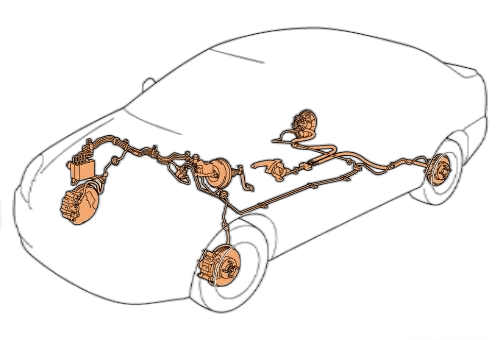
Lista di controllo del veicolo prima di un viaggio a guida autonoma su lunghe distanze
- Hanna
- Settembre 9, 2025

1、Fluid System
Engine Oil: Engine oil is the “blood” of the engine, responsible for lubricating, cooling, and cleaning internal parts. Before a long-distance trip, carefully check if the oil level is within the normal range and observe the color and viscosity of the oil. If the oil has turned black or contains impurities, it indicates the oil quality has deteriorated and should be replaced promptly. Be sure to also replace the oil filter to ensure the engine runs smoothly and stably under prolonged high load.
Coolant: The function of the coolant is to prevent the engine from overheating or freezing in low temperatures. When checking, ensure the fluid level is sufficient and verify that the coolant concentration matches the seasonal requirements (especially pay attention to anti-freeze performance in winter). Insufficient coolant can lead to engine overheating, and prolonged driving may even cause engine damage.
Brake Fluid: Brake fluid directly affects the sensitivity and safety of braking. Before setting off, check if the brake fluid level is within the normal range and inspect its color to ensure it isn’t too dark or close to the replacement cycle. Aged brake fluid easily absorbs moisture, which reduces braking performance and poses a serious danger on long trips or downhill sections, so you should not overlook it.
Windshield Washer Fluid: During long periods of high-speed driving, the windshield can accumulate dust, mud spots, and insect residue, which can impair driving visibility. Be sure to top up the windshield washer fluid (recommended to use antifreeze type in winter) and ensure the nozzles are spraying smoothly, so the windshield can be cleaned at any time, ensuring good driving visibility.
2、Tires
Tire Pressure: Tire pressure directly affects the stability of the vehicle and fuel consumption. Low tire pressure increases fuel consumption, accelerates tire wear, and even poses a risk of a blowout at high speeds. On the other hand, high tire pressure reduces the contact area between the tire and the ground, affecting grip and braking performance. Before a long-distance trip, it is recommended to inflate the tires according to the factory tire pressure values indicated on the B-pillar label on the driver’s side door frame to ensure balanced tire pressure.
Tread Depth: The depth of the tire tread determines its drainage performance and anti-skid ability. Shallow treads increase the risk of skidding on rainy or slippery surfaces, which raises the risk of accidents. If the tread depth feels significantly shallow, it’s important to replace the tires promptly to ensure driving safety.
Spare Tire: During long-distance driving, road conditions and unforeseen situations can be unpredictable, and tire blowouts or leaks can occur. If you don’t have a spare tire, it can disrupt your journey and leave you stranded. Therefore, before departure, make sure the spare tire is in good condition (including tire pressure and tread depth) and check that all emergency tools are available, so you can change the tire promptly and continue your journey if needed.
3、Brakes
Brake Pads and Brake Discs: The braking system is the core of vehicle safety, especially during long-distance and high-speed driving. Before departure, check the thickness of the brake pads. Replace brake pads immediately when they are too thin or near the wear limit. Scratches, cracks, or uneven wear on the brake discs also reduce braking performance. Perform a professional inspection and maintenance promptly if you notice soft brakes, unusual noises, or extended stopping distances.
Brake Pedal and Handbrake: The brake pedal should feel firm and responsive when pressed. If the brake pedal feels too soft or requires pressing all the way down to stop the vehicle, low brake fluid or a braking system fault may be causing it. Also check the handbrake to ensure it firmly holds the vehicle in place, especially on inclines, and prevents rolling when parked.
Steering System: The smoothness and accuracy of steering are critical to both driving control and safety. Check if the steering wheel turns smoothly at both low and high speeds, and whether there is any abnormal shaking or deviation. If the steering wheel feels heavy or gets stuck, low power steering fluid or worn components may be causing it, and you should repair it as soon as possible.
4、Lighting
Headlights: Check if the low beams and high beams are functioning properly and ensure the adjustment angle is correct. This will prevent impaired visibility at night or blinding oncoming drivers.
Fog Lights: Verify if both the front and rear fog lights can be turned on and are working correctly.
Turn Signals / Hazard Warning Lights: Test the left and right turn signals, as well as the hazard warning lights, to ensure the flashing frequency is normal.
Brake Lights: Have someone assist by pressing the brake pedal while you check if each brake light illuminates properly.
Reverse Lights: Check if the reverse lights come on when the vehicle is in reverse gear, ensuring safe reversing at night.
Dashboard and Indicator Lights: Inspect all the lights on the dashboard to ensure they are functioning correctly, particularly the oil, brake, and battery warning lights.
5、Battery Inspection
Tensione: Ensure the battery voltage is within the normal range to support starting the engine and meeting electrical demands during driving.
Terminals: Check that the battery terminals are securely connected to avoid loosening or corrosion.
Appearance: Inspect the battery casing for any abnormal signs such as bulging or leakage.
Lifespan: Based on the battery’s age and performance, assess whether it can still reliably support the trip. If it’s approaching the end of its lifespan or in poor condition, it’s advisable to replace it beforehand to avoid being unable to start the vehicle due to battery failure during the journey.
6、Air Conditioning Test
Cooling and Heating Functions: Test each mode (cooling, heating, defrost, and air circulation) to ensure sufficient airflow and responsive temperature adjustments. After starting the air conditioning, observe whether the temperature change is normal to avoid delayed cooling or heating effects.
Air Quality: Check if the air from the vents is fresh and free of odors. If there is an unusual smell, it may be due to a clogged air filter, water accumulation in the evaporator, or mold growth in the ducts. Clean or replace the filter promptly, and inspect the ducts for mold.
Cooling Effect: Test the cooling performance in hot weather. If the cooling seems insufficient, check the refrigerant level. Low refrigerant or leaks can reduce cooling efficiency, so if needed, visit a professional repair shop to top up or check for refrigerant leaks.
-
MRCARTOOL L202 Manometri per refrigeranti e manometri per aria condizionata
Valutato 4.87 su 5 su base di 38 recensioni$79.90Il prezzo originale era: $79.90.$59.90Il prezzo attuale è: $59.90. -
MRCARTOOL L205 Set di manometri per collettori HVAC
Valutato 5.00 su 5 su base di 4 recensioni$129.00Il prezzo originale era: $129.00.$79.90Il prezzo attuale è: $79.90. -
MRCARTOOL L302 Misuratore digitale di refrigerante e misuratori HVAC
Valutato 4.90 su 5 su base di 20 recensioni$149.99Il prezzo originale era: $149.99.$109.90Il prezzo attuale è: $109.90. -
MRCARTOOL L505 Set di manometri per collettori HVAC digitali $259.00
7、Belt and Hose Inspection
Inspect the surface of the belts for cracks, wear, delamination, or oil stains. Ensure the belt tension is moderate, with no slack or excessive tightness. If obvious wear or unusual noise is detected, replace or adjust the belts promptly.
Check the hoses for signs of aging, cracking, bulging, or leakage. Ensure the hose connections are secure, and check that clamps or fasteners are not loose or missing. Make sure the hose layout is neat and that there is no risk of contact or friction with high-temperature components.
8、Emergency Preparedness
9、Long-Distance Travel Tips🙋
Macchina per il cambio del liquido dei freni Guida completa
I. Perché è necessaria una macchina per il cambio del liquido dei freni? 🚗 Pericoli del liquido freni invecchiato [...]
Ott
Sintomi di un iniettore di carburante difettoso: Come capire se l'iniettore del carburante è guasto
Quando il motore di un'auto, di una moto o di un'imbarcazione inizia a perdere potenza o a girare al minimo, un [...]
Ott
Come rimuovere gli iniettori del carburante?
È davvero necessario pulire gli iniettori del carburante? Il dibattito sulla necessità o meno di pulire gli iniettori [...]
Ott
Perché le officine professionali utilizzano gli scambiatori del liquido dei freni? - Capire il vero valore degli scambiatori di fluido dei freni
Se gestite un'autofficina, è probabile che abbiate incontrato clienti che vi hanno chiesto: "I freni sono davvero [...]
Ott
Problemi dell'auto: falsi problemi comuni
Durante la guida, può capitare di vedere improvvisamente una fila di spie sul cruscotto, di notare [...]
Set
Problemi alla trasmissione: 5 segnali di allarme precoci
Nella guida quotidiana, la trasmissione è quasi sempre in funzione. Non solo trasferisce il motore [...]
Set
Home Smart Charging Pile, la vostra soluzione di ricarica ideale!
Con la crescente popolarità dei veicoli elettrici nel Regno Unito e in Europa, la domanda di [...]
Set
Manutenzione auto autunnale per veicoli elettrici, ibridi e a benzina
L'arrivo dell'autunno porta con sé un clima più fresco, giornate più corte, notti più lunghe e persino l'imminente [...]
Set


















































































